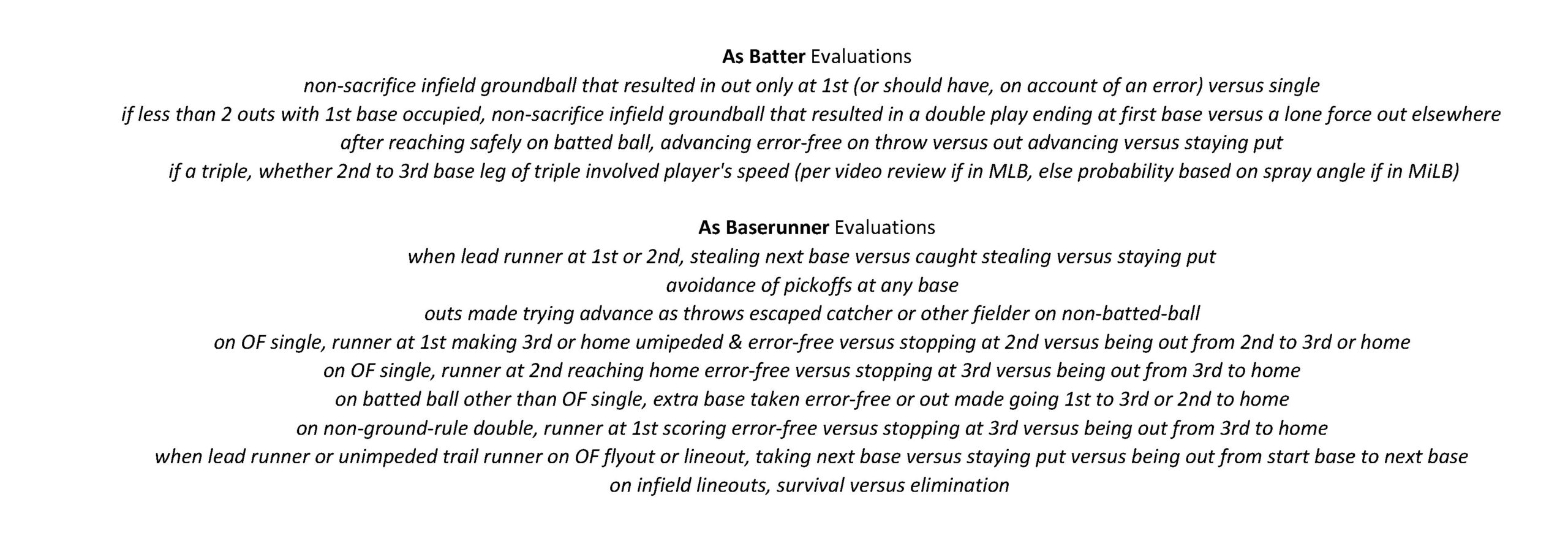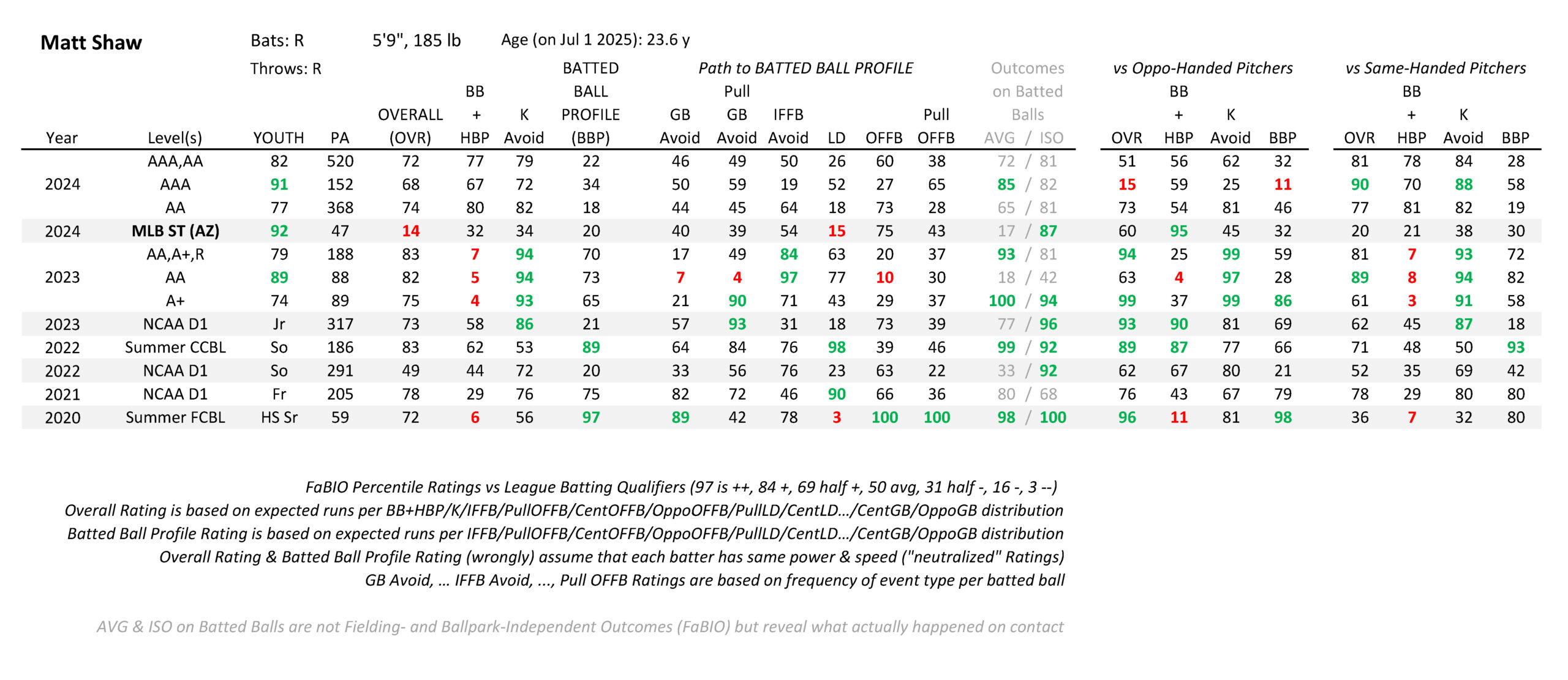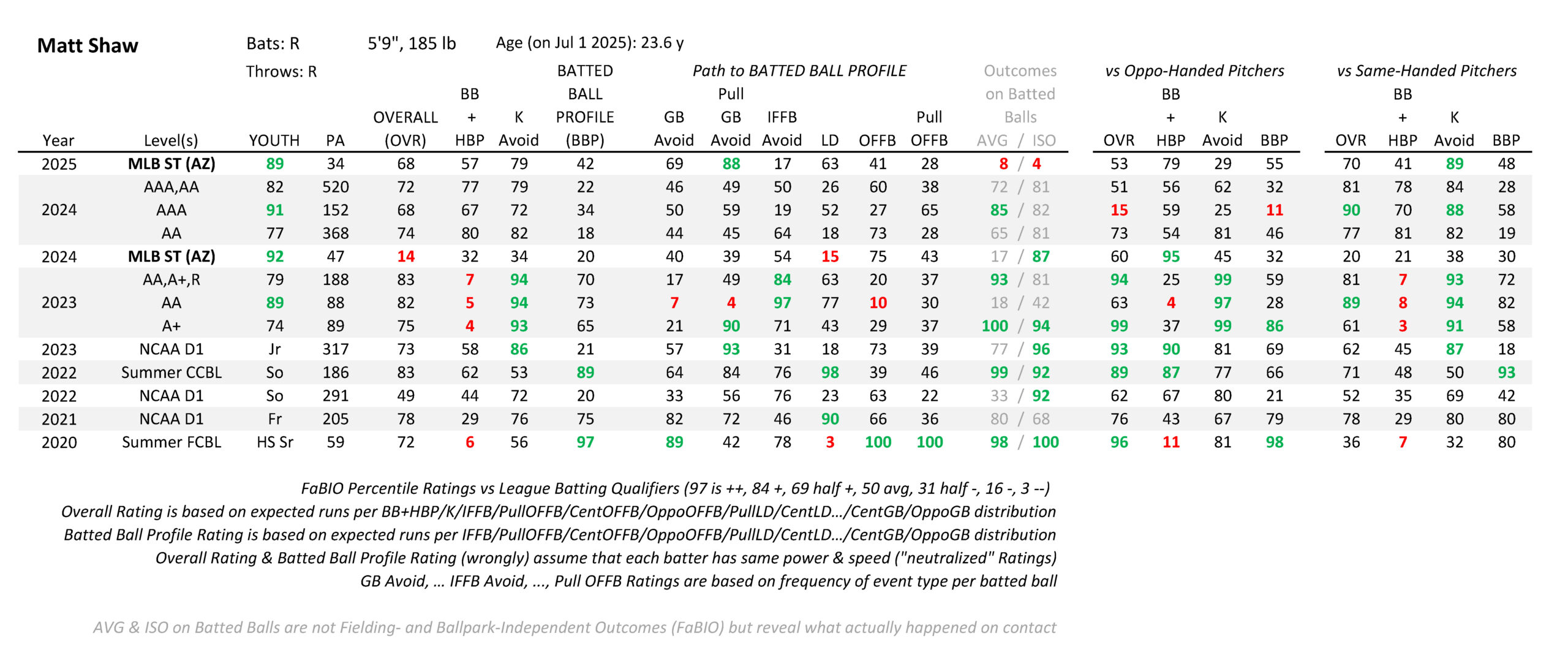Matt Shaw's fantasy baseball prospect outlook, sleeper potential for dynasty leagues. Matt uses his custom suite of fundamentals-rooted evaluation tools.
As a collegian, third baseman Matt Shaw of the Chicago Cubs impressed the FaBIO batter evaluation model more during wood-bat summer league play than he did in his three NCAA seasons.
How do the professional plate profiles compare to the amateur precedents? What percentage of his minor league circuit peers would you guess that he beat at offensive running? What are the most important areas of his offensive profile for fantasy players to watch?
Let's take a look at Shaw's profile and see what it can tell us as far as how great of a prospect he can be for dynasty leagues.
Be sure to check all of our fantasy baseball lineup tools and resources:- Fantasy baseball trade analyzer
- BvP matchups data (Batter vs. Pitcher)
- PvB matchups data (Pitcher vs. Batter)
- Who should I start? Fantasy baseball comparisons
- Daily MLB starting lineups
- Fantasy baseball closer depth charts
- Fantasy Baseball live scoreboard
- Fantasy baseball injury reports
Brief Explanation of the FaBIO Model
My Fielding- and Ballpark-Independent Outcomes (FaBIO) evaluation model sorts every plate appearance into one of 12 outcome bins (BB+HBP, K, IFFB, Pull-Third OFFB, Center-Third OFFB, Oppo-Third OFFB, Pull-Third LD, Center-Third LD, Oppo-Third LD, Pull-Third GB, Center-Third GB, Oppo-Third GB) and charges the pitcher and batter with their league's mean runs value for said particular event that season.
Dividing a batter's total number of expected runs by plate appearance (PA) yields expected runs per PA that can be percentile ranked relative to the league mean and standard deviation for that parameter amongst league batter qualifiers to arrive at their Overall Rating.
Its three subcomponents of BB+HBP Rating (based on BB+HBP per PA), Strikeout Avoid Rating (K Avoid, based on K per PA), and Batted Ball Profile Rating (expected runs per batted ball) are also reported to identify the path the batter traveled to reach their Overall Rating.
Overall Rating and Batted Ball Profile Rating of batters should be considered power- and speed-neutralized metrics since the real-world runs value of a single batter's typical OFFB or LD varies with their strength, and the expected runs value of their typical GB varies with their speed.
To better understand the Path to Batted Ball Profile, we will also examine percentile ratings for select batted ball event types (on a per-batted ball basis). To check how well expected batted ball outcomes match real-world ones, we will compute percentile ratings for hits (AVG) and isolated power (ISO, or simply extra bases) on batted balls (recognizing full well that these two parameters are neither fielding- nor ballpark-independent outcomes).
What most explains a batter's ability to generate hits (AVG) on batted balls is any LD, IFFB avoidance, Pull-Third OFFB, and Pull-Third GB avoidance. What most explains their ability to generate extra bases (ISO) on batted balls is any OFFB, Pull-Third OFFB, Pull-Third LD, and IFFB avoidance.
A percentile rating of 97 amounts to plus-plus (two standard deviations above the mean), 84 is plus (one standard deviation above the mean), 69 is half plus, 50 is average, 31 is half minus, 16 is minus, and three is minus-minus.
A new addition to this suite of evaluation models is the Offensive Running Rating. This tool quantifies how each relevant inning's run expectancy was impacted by the player's action or inaction as either a batter or baserunner on specific types of plays that are more likely to involve one or both of their speed, offensive running technique, and acumen.
The evaluated batter and baserunner events are summarized in the graphic.
Prospect Analysis: Matt Shaw
Evolution of College Plate Profile
Matt Shaw played three summers of wood-bat collegiate league baseball before his 2023 D1 draft season, including a summer in 2021 split across two lesser-known Northeast circuits that never made it into the FaBIO archives. Batted ball fundamentals and outcomes from those summer wood bat leagues stand out positively enough compared to those from the University of Maryland to wonder if Shaw may have been better off entering pro baseball after high school.
Based on the progression of the collegiate profiles, one could project a pro batter with half minus to average BB+HBP, average to half minus K Avoid, and uncertain Batted Ball Profile and AVG and ISO marks. LD Rating ran extremely volatile, and thus so too might hitting (AVG) ahead.
A reasonably high ISO despite Pull OFFB often lagging OFFB affirms that Shaw generated extra bases to all fields, a trait that might not translate so well to wood bat professional baseball at his smaller stature.
Seasonal plate profiles that typically rated poorer against same-handed pitchers than opposite-handed ones raised questions as to whether the right-handed batter may struggle ahead while more often facing right-handers than left-handers.
With considerations like these in mind and leaning, “If he hit so well with wood before, he will do it again," the Cubs selected Shaw with the 13th pick of the 2023 MLB Draft and signed him with a $4.8 million bonus.
Evolution of Pro Plate Profile
After 11 tune-up PA with a rookie Arizona Complex League squad, Shaw was sent to the High-A affiliate for 89 PA over which he produced very loud AVG and ISO marks despite not so many LD or Pull OFFB. He then logged 88 Double-A PA but was unable to generate much AVG or ISO despite improving LD versus High-A.
The relative constants between the two similarly-sized full-season-level stints were the four and five BB+HBP Ratings and the 93 and 94 K Avoid Ratings.
Shaw received a larger dose of 47 PA in 2024 MLB spring games and produced 32 BB+HBP, 34 K Avoid, and 20 Batted Ball Profile Ratings. After being so down in 2023 MiLB debut, BB+HBP rated in half to full plus neighborhood over 2024 Double-A and Triple-A stops, as did K Avoid. However, the Batted Ball Profile and its path in Double-A mirrored its spring game precursor and only marginally improved while in Triple-A.
Shaw produced a 2024 MiLB half-to-full plus AVG and almost full-plus ISO despite a full-to-half minus batted ball profile fundamentals, which pegs that vintage of him as being overly reliant on exit velocity for hits and extra bases and shorter on the variety of launch and spray fundamentals that purer hitters traditionally sport.
The 2025 spring game action was limited to 34 PA by an early camp oblique injury and the Cubs' mid-March trip to Japan for two exhibition games against the Dodgers that counted in the regular season standings. There, we saw the continuation of good BB+HBP and K Avoid from 2024 MiLB. Slightly improved hit fundamentals boosted Batted Ball Profile to 42, but Shaw could barely generate any (eight) AVG or ISO (four) on batted balls.
The Cubs would opt to add Shaw to their MLB roster for the two-game Japan Series, even though he did not seem in an overly good position to hit MLB pitching between the spring outcomes and prior season batted ball profile fundamentals.
The former collegiate pitcher's handedness splits bias flipped with the 2023 move from High-A to Double-A, and since then, plate profiles have continued to rate better versus same-handed pitchers, with the lone exception being the 2024 spring games. Shaw had trouble with strikeouts (K Avoid) against left-handers (opposite-handed pitchers) in 2024 Triple-A and again in 2025 MLB spring games.
Evolution of Pro Offensive Running
Shaw was rated among the top four percent of offensive runners in his combined 2023 leagues per a 96 mark. An 88 2023 Double-A Rating was followed by a 90 2024 Double-A Rating. The As Batter Rating stayed up in Triple-A per an 83, but the As Baserunner Rating swooned to just six while there, suggesting that he was perhaps protecting a bad wheel or other ailment when others were at the plate.
Across both 2024 stops, Shaw rated shy of plus at Offensive Running Rating.
Between the 2024 and 2023 MiLB Offensive Running Ratings and top sprint speeds that now rate in the 93rd percentile of 2025 MLB players, Shaw should be a plus MLB offensive runner.
Fantasy Focus
Matt Shaw should eventually post half to full plus strikeout avoidances, with BB+HBP percentages that skew nearer average than half plus. His batted-ball outcomes will be volatile and feature longer cold spells as long as this smaller player's ability to generate hits and extra bases on batted balls remains so much more dependent on exit velocity than traditionally favorable launch and spray angles.
Per Shaw’s historical bias toward producing extra bases to the center of the field, he should benefit more from the home Wrigley outfield bleachers, playing more reachable to the center-third wedge of the field on days when winds do not blow relatively in from that direction.
Yet, the same trait is not so favorable to hitting for either average or power in most MLB parks, and perhaps it is still more so for a player like him who is shorter in height and mass.
Shaw may struggle to hit for average for much of the 2025 MLB season. Between that and ordinary BB+HBP percentages, relatively fewer opportunities will present themselves to utilize his plus offensive running abilities. Reaching base less could spark increased aggression in base stealing as one route to contributing more expected offensive runs value to his MLB team.
Recently optioned to Triple-A, Shaw was probably destined to be sent there at some point in 2025 by the "Win now!" Cubs for targeted work on his hitting fundamentals. A repeat Triple-A stint should not be viewed as a grand disappointment since he had only logged 152 PA at that level through the end of 2024.
Will the fielding fundamentals and tools ultimately better suit a real-world MLB lineup at third or second base? Can he play a passable shortstop in a pinch?
Download Our Free News & Alerts Mobile App
Like what you see? Download our updated fantasy baseball app for iPhone and Android with 24x7 player news, injury alerts, sleepers, prospects & more. All free!

More Fantasy Baseball Advice





 RADIO
RADIO




























